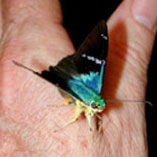Hidden diversity: DNA ’barcoding’ reveals a common butterfly is actually 10 different species

Credit: Daniel Janzen
A common butterfly, found in a variety of habitats from the southern United States to northern Argentina, is actually comprised of at least 10 separate species, according to researchers from the University of Pennsylvania.
Astraptes fulgerator, a medium-large skipper butterfly, is a routine visitor to urban gardens and tropical rainforests. While the “species” has been known to science since 1775, only now has examination of a small and standardized signature piece of the genome – a technique called DNA barcoding – shown that this “species” is really an amalgam of a number of genetically distinct lineages, each with different caterpillars and preferences in food plant and ecosystem.
However, as many as six species can live in the same place, which strongly suggests mating segregation. Because the adults differ at best only slightly in appearance — so slightly that it was attributed to ordinary “variation” — this finding may have larger implications for maintaining biodiversity.
“It raises the questions of how many other species out there are really multiple species like this one and what that might mean to wildlife conservation,” said Daniel Janzen, co-author of the study and professor in the Department of Biology in Penn’s School Arts and Sciences. “We might lament the local extinction of a plant or animal but take comfort in the notion that the species lives on elsewhere. Well, what if that extinct animal was the only example of a genetically distinct species, hiding inside a morphology similar to the surviving species?”
Janzen and his colleagues report their findings in the Sept. 29 issue of the Proceedings of the National Academy of Sciences. Their research began during 25-year-long inventory of the wildlife in the Area de Conservación Guanacaste, a large conservation zone of dry, rain and cloud forests in northwestern Costa Rica. They noticed that, amid the more than 2,500 wild-caught caterpillars of A. fulgerator, many could be separated by slight variations in color, which then could be linked to the particular plants the caterpillars ate.
It soon became obvious that A. fulgerator was, indeed, a complex of a number of separate species whose adult forms looked remarkably similar. When the centuries-old method of telling insects apart — the examination of their genitalia by John Burns at the Smithsonian Institution –- proved inconclusive, the team turned to a recently emerging method for discriminating species: DNA “barcoding,”
In much the same way that supermarket barcoding can distinguish one brand of canned beets from another, DNA barcoding is an attempt to classify species by variations in a small signature and standardized portion of gene called cytochrome c oxidase I, common to all life. Based at the University of Guelph in Canada, the Barcode of Life Database can determine patterns of COI gene variation within a given group of specimens. If the specimens in question differ by more than a few percent in their base pairs of DNA in this gene, it is likely that they have come from different populations.
Paul Hebert and Erin Penton at Guelph were able to extract the necessary DNA from 484 adult butterflies deposited at the Smithsonian –- all raised from the much larger pool of caterpillars caught in Costa Rica by Janzen, Winnie Hallwachs and a team of 17 Costa Rican parataxonomists –- despite the fact that these butterflies have been dried museum specimens for as long as 23 years. Where possible, they included at least 20 individuals from each group of food plant, color variation and preferred habitat. As a result, they found 10distinct species within the group known as A. fulgerator in an area the size of the greater Philadelphia area and as many as six species in a place no larger than the 262-acre Penn campus.
“Given the vast range of the supposed A. fulgerator species, it doesn’t take much imagination to realize that there are probably a great many more hidden species out there,” Janzen said. “Our results add to the evidence that cryptic species are prevalent, which I believe is of critical importance if we are to document the health of the environment and the richness of global biodiversity.”
Media Contact
All latest news from the category: Life Sciences and Chemistry
Articles and reports from the Life Sciences and chemistry area deal with applied and basic research into modern biology, chemistry and human medicine.
Valuable information can be found on a range of life sciences fields including bacteriology, biochemistry, bionics, bioinformatics, biophysics, biotechnology, genetics, geobotany, human biology, marine biology, microbiology, molecular biology, cellular biology, zoology, bioinorganic chemistry, microchemistry and environmental chemistry.
Newest articles
Humans vs Machines—Who’s Better at Recognizing Speech?
Are humans or machines better at recognizing speech? A new study shows that in noisy conditions, current automatic speech recognition (ASR) systems achieve remarkable accuracy and sometimes even surpass human…

Not Lost in Translation: AI Increases Sign Language Recognition Accuracy
Additional data can help differentiate subtle gestures, hand positions, facial expressions The Complexity of Sign Languages Sign languages have been developed by nations around the world to fit the local…

Breaking the Ice: Glacier Melting Alters Arctic Fjord Ecosystems
The regions of the Arctic are particularly vulnerable to climate change. However, there is a lack of comprehensive scientific information about the environmental changes there. Researchers from the Helmholtz Center…



